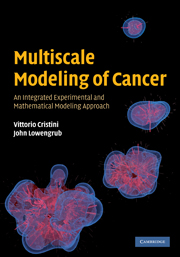Book contents
- Frontmatter
- Contents
- List of contributors
- Preface
- Acknowledgements
- Notation
- Part I Theory
- 1 Introduction
- 2 Biological background
- 3 Continuum tumor modeling: single phase
- 4 Analysis and calibration of single-phase continuum tumor models
- 5 Continuum tumor modeling: multiphase
- 6 Discrete cell modeling
- 7 Hybrid continuum–discrete tumor models
- 8 Numerical schemes
- Part II Applications
- References
- Index
5 - Continuum tumor modeling: multiphase
from Part I - Theory
Published online by Cambridge University Press: 05 October 2010
- Frontmatter
- Contents
- List of contributors
- Preface
- Acknowledgements
- Notation
- Part I Theory
- 1 Introduction
- 2 Biological background
- 3 Continuum tumor modeling: single phase
- 4 Analysis and calibration of single-phase continuum tumor models
- 5 Continuum tumor modeling: multiphase
- 6 Discrete cell modeling
- 7 Hybrid continuum–discrete tumor models
- 8 Numerical schemes
- Part II Applications
- References
- Index
Summary
Background
In this chapter we develop and analyze multiphase mixture models of solid tumor growth and include their coupling via angiogenesis to the tumor-induced vasculature. Mixture models incorporate more detailed biophysical processes than can be accounted for in single-phase models, and they provide a more general framework for modeling solid tumor growth. Phenotypic and genetic heterogeneity (e.g., mutations) in the cell population can be represented, and this is a critical improvement towards realistically simulating mutation-driven heterogeneity.
A multiphase approach describes a tumor as a saturated medium, comprising at least one solid phase and one liquid phase. The approach can be generalized to incorporate any number of additional phases describing multiple cell species and extracellular matrix components. At a given physical location, the mass or volume fractions describe the relative amounts of different cell clones, necrotic tissue and host tissue. The governing equations consist of mass and momentum balance for each phase, mass and momentum exchange between phases, and appropriate constitutive laws to close these equations. The mixture-model approach eliminates the need to enforce complicated boundary conditions across the tumor–host interface (and other species–species interfaces) that would have to be satisfied if the interfaces were assumed to be sharp. Also, this methodology does not require the interface to be tracked as is the case for a sharp interface.
Recently, multiphase mixture models have been developed to account for heterogeneities in cell type and in the mechanical response of the cellular and liquid tumor phases.
- Type
- Chapter
- Information
- Multiscale Modeling of CancerAn Integrated Experimental and Mathematical Modeling Approach, pp. 67 - 87Publisher: Cambridge University PressPrint publication year: 2010

